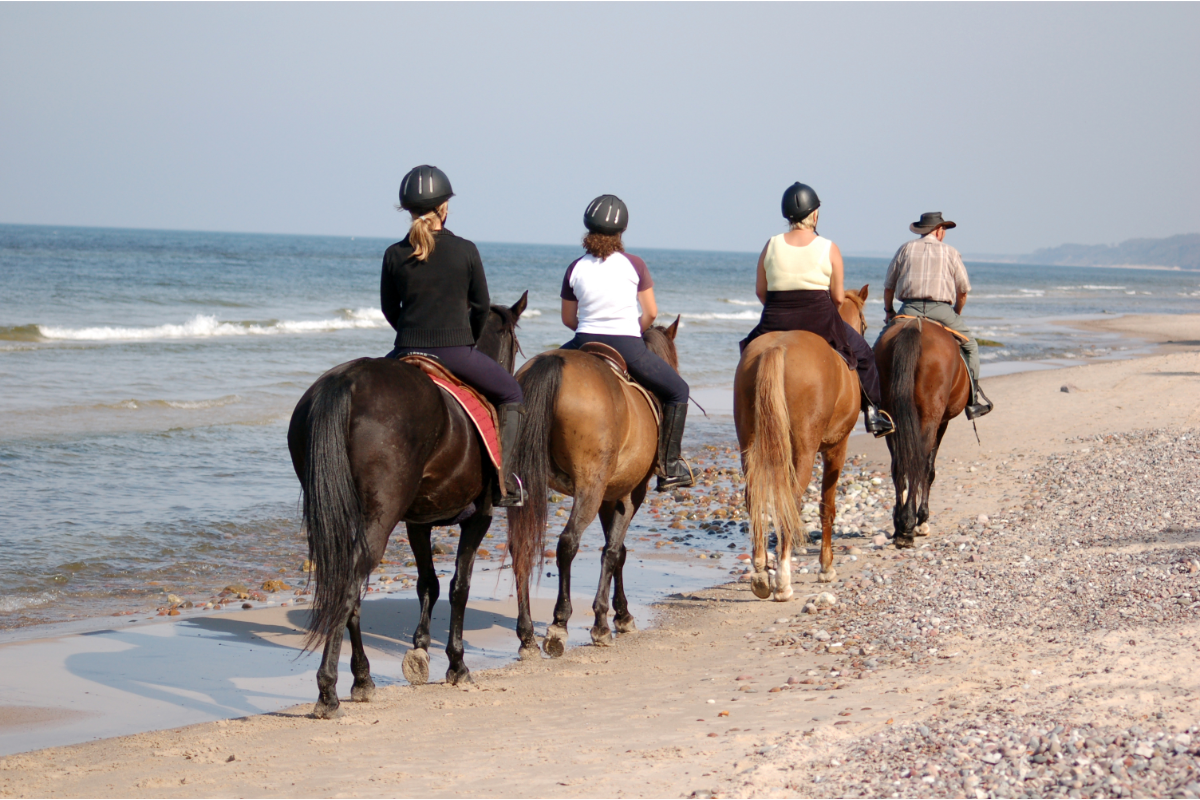The summer period is characterised by dry, hot and sunny weather, which can have a significant impact on the health and well-being of horses. High temperatures, dusty environments, hard ground and increased exposure to UV rays can have a negative effect on equines, especially those living outdoors. In addition, summer marks the proliferation of winged insects, which are sources of mechanical discomfort and potential vectors of disease. Faced with these challenges, it’s crucial to know and apply effective natural remedies to keep horses healthy.
Heat stroke
In very hot weather, horses may be unable to thermoregulate during intense exercise, reaching a temperature of over 41°C instead of 37.5°C to 38.5°C. This is a vital emergency, as peripheral vasodilation diverts blood away from vital organs (heart, kidneys, brain).
To treat heatstroke, stop all activity immediately, place the horse in a cool, well-ventilated area, use a ventilator and wet the horse with cool water. Gradually shower the limbs, chest and neck, then wring out with a heat knife. Give water at room temperature and massage gently to stimulate blood circulation. Take the temperature regularly and consult a vet if the condition does not improve quickly.
In the event of a heatwave, make sure the horse has plenty of water, offer to drink regularly, use electrolytes after exercise and work early in the morning or late at night. Protect the horse with a shaded shelter and ensure adequate ventilation in the stables. Give a hydrating feed such as a mash and supplement with carrots and apples. Add aloe vera pulp to provide the necessary nutrients and combat dehydration. Be careful with nursing mares and older horses.
Photosensitisation and sunburn
Horses with pink skin are more sensitive to UV rays, especially in hairless areas such as around the eyes and the tip of the nose. These depigmented areas absorb more UV than pigmented areas. In summer, these horses can suffer burns characterised by redness, sensitivity and scaling.
Photosensitisation aggravates these reactions, causing swelling and crusting due to the accumulation of photosensitising agents through ingestion or contact with certain plants (St John’s wort, white clover) or medicines (tetracyclines). Plants such as ragwort, containing pyrrazole alkaloids, cause liver problems and photosensitisation.
Repeated exposure to UV rays can lead to the development of skin tumours in the eye area. To prevent sunburn, use masks covering the ears and nose, bring horses indoors between 12pm and 3pm, and apply sunscreen to hairless areas. Water-resistant zinc oxide is recommended, but not around the eyes.
To combat a burn, you can apply a thick layer (1 cm) of aloe vera gel. Here’s a formula for a homemade balm:
- Spike lavender essential oil 3%, powerful anti-inflammatory and skin regenerator
- Tea tree essential oil 2%, antimicrobial
- Camelina vegetable oil 20%, promotes healing
- Shea butter 75%, moisturises and regenerates the epidermis
You can add a few drops of chamomile essential oil.
Equine recurrent summer dermatitis (ERD)
Recurrent equine summer derm atitis (RECD) results from hypersensitivity to allergens in the saliva of haematophagous midges of the Culicoides genus. These insects, particularly the females, bite horses, triggering an intense allergic reaction in certain genetically predisposed individuals. In France, around 10% of horses suffer from this disease.
EERD causes recurrent itching and skin lesions, mainly in spring and summer. Affected horses develop papules, crusts and alopecia, often on the dorsal and ventral lines. Severe cases lead to weight loss and increased nervousness.
To prevent EERD, it is crucial to limit Culicoides bites. This can be achieved by using mosquito nets, bringing horses in at times of peak insect activity, and applying long-acting insecticides. Corticosteroids and antihistamines can relieve symptoms, but prolonged use is risky. Food supplements rich in omega 3 and 6, as well as soothing lotions, can also be beneficial. Phyto-aromatherapy is also proving very useful in managing EERD.
Here’s an oil to apply to areas particularly affected by scratching:
- Neem vegetable oil 60%, repels insects and promotes healing
- Calendula oily macerate 30%, regenerates the skin
- Tea tree essential oil 2%, prevents infections
- Lemon eucalyptus essential oil 4%, soothes itching and repels insects
- True lavender essential oil 3%, promotes healing
- Rosemary cineole essential oil 1%, promotes hair regrowth
Vector-borne diseases
Dusty environments and asthma
A dusty environment exacerbates clinical respiratory signs in horses with equine asthma. To prevent these problems,exposure to dust should be reduced by :
- Watering work surfaces and passage areas
- Reserving the grassiest paddocks and meadows
- Regularly moving watering and feeding areas subject to trampling
Emphysema, also known as “sprouting”, is a chronic respiratory disease that compromises a horse’s ability to breathe out air. This condition, similar to human asthma, results from chronic inflammation of the lungs, often triggered by hypersensitivity to dust and mould in hay and straw.Inhalation of these irritants causes an allergic reaction, leading to thickening of the respiratory mucosa and excessive mucus production.
The mucus accumulates, obstructing the airways, while bronchospasm further reduces the space for air circulation. In the long term, this can lead to pulmonary fibrosis, making the lungs rigid and causing irreversible damage. Ongoing management of the horse’s environment is essential to alleviate the symptoms.
To relieve your emphysematous horse, here’s a natural solution if you have an inhalation bag or inhaler:
- Hydrolat of Hyssop 1/3, antiseptic and antispasmodic for the respiratory tract
- Eucalyptus globulus hydrolate 1/3, mucolytic and bronchodilator
- Yarrow hydrolate 1/3, anti-allergic
Warning: this solution has bronchodilator properties and should not be used in windy conditions
In addition, oral gemmotherapy is very useful. Blackcurrant is a powerful general anti-inflammatory and anti-allergy agent. Similarly, Oxygen Bramble oxygenates tissues with a pulmonary tropism, reducing pulmonary fibrosis, the final stage of emphysema.





